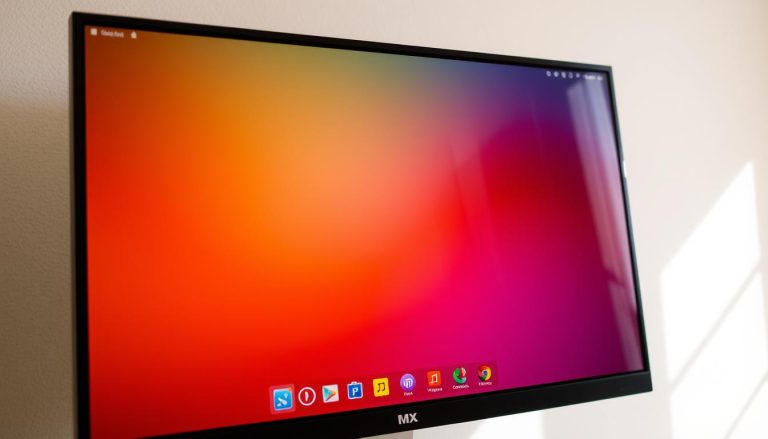What if your aging computer could run as fast as the day you bought it? Many people assume sluggish performance means it’s time for an expensive upgrade. We’re here to challenge that belief. Our team conducted extensive testing to find operating systems that breathe new life into hardware. We evaluated factors like hardware demands, ease of setup, and available software. This process ensures our recommendations are accurate and reliable.
Choosing the right software can dramatically improve your computer’s responsiveness. You can achieve faster boot times and smoother operation. This approach maximizes your existing machine’s potential.
This guide is perfect for anyone wanting to revive an old machine or optimize a modern one. We explain the key differences between various options. Our analysis focuses on efficiency and user experience.
Key Takeaways
- Lightweight operating systems can significantly improve speed on older or limited hardware.
- Our testing methodology evaluates system requirements, performance, and ease of use.
- The right choice leads to faster startup and reduced memory consumption.
- These solutions are ideal for extending the lifespan of your current computer.
- We clarify what “lightweight” means in terms of resource usage and features.
- Both beginners and experienced users can benefit from these efficient alternatives.
- There is a trade-off between minimal resource use and pre-installed software.
Understanding Lightweight Linux Distros
Resource-conscious software choices make a significant difference for computers with limited capabilities. We define these efficient operating systems by their ability to operate smoothly on minimal hardware. They represent a practical approach to computing.
Defining a Lightweight Linux Distro
What makes an operating system “lightweight? It’s about minimal resource consumption while maintaining functionality. These systems use less memory and storage than standard alternatives. They prioritize efficiency over extensive pre-installed software.
Modern versions balance performance with contemporary features. They often include systemd and current kernel versions. This combination ensures both efficiency and compatibility with newer applications.
For detailed technical comparisons, see the comparison of lightweight Linux distributions. This resource helps users understand the specific differences between available options.
Ideal Use Cases and Benefits
These operating systems excel in specific scenarios. They’re perfect for reviving older computers that struggle with modern software demands. Many people use them as secondary machines for specialized tasks.
Key advantages include:
- Extended hardware lifespan
- Faster system responsiveness
- Reduced energy consumption
- More resources available for applications
Both beginners and experienced users find value in these efficient systems. They serve well as learning platforms or dedicated workstations. The trade-off involves fewer pre-installed applications but greater control over system resources.
Key Features and Performance Metrics
Performance testing reveals substantial differences in how efficiently various operating systems utilize available resources. Our standardized evaluation provides clear data for comparing different options.
System Requirements and Minimal Hardware Specs
The minimum hardware requirements vary significantly across different operating systems. Some options can run with as little as 128 MB RAM, while others recommend 2 GB for optimal performance.
Storage space demands also show considerable variation. Installation footprints range from under 6 GB to nearly 8 GB. This affects which systems work well on older machines with limited capacity.
Performance Benchmarks and Speed Tests
Our testing methodology used identical virtual environments with 2 CPUs and 4 GB RAM. This ensured fair comparisons across all evaluated systems.
Memory consumption at idle showed dramatic differences. For example, Lubuntu used only 392 MB RAM, while other options consumed over 800 MB. CPU usage followed similar efficiency patterns.
These metrics translate directly to real-world performance. Lower resource usage means faster response times and better multitasking capabilities on limited hardware.
User Experience and Desktop Environments
The interface you interact with daily plays a huge role in your satisfaction with any operating system. We examine the various desktop environments that balance speed with usability.
Common Desktop Environments in Lightweight Distros
Efficient systems use different graphical interfaces. For instance, antiX employs the IceWM window manager for minimal resource use. It includes a custom control panel for deep configuration.
Lubuntu features the LXQt desktop environment, known for its quick response times. Its Configuration Center provides straightforward access to settings. This is similar to tools used for system configuration tasks.
Other popular options include Xfce, used by Zorin OS Lite and Linux Lite. Zorin OS demonstrates how Xfce can be polished to a high degree. Openbox, found in BunsenLabs, offers extensive customization for experienced users.
The right interface choice significantly impacts the overall experience. Some environments prioritize a familiar feel, while others offer ultimate efficiency.
Reviewing the best lightweight linux distro for Faster Performance
Our comprehensive testing has identified several standout operating systems that deliver exceptional speed on modest hardware. We will examine their unique strengths and ideal use cases.
Top Contenders: antiX, BunsenLabs, Linux Lite and More
antiX stands out for its minimal demands. It uses the IceWM window manager for speed and includes a useful control panel. Installation is remarkably fast, taking just 3-10 minutes.
BunsenLabs continues the Crunchbang legacy with a smartly configured Openbox environment. It offers blazing fast performance on its Debian 11 foundation. This option is perfect for users who value customization.
Linux Lite is specifically designed to ease the transition for Windows users. Based on Ubuntu LTS, it features the familiar Xfce desktop and includes essential apps like Chrome. Its zRAM technology helps maximize available memory.
Lubuntu is a premier choice for older machines. Its LXQt desktop is highly efficient, and the minimum RAM requirement is now just 500MB. This provides a great balance of modern features and low resource use.
Other notable options include:
- Porteus: Runs from RAM for incredible speed.
- Puppy Linux: A veteran with a vast application range.
- Tiny Core: An ultra-minimal, modular project.
Each distribution serves a specific purpose. The right choice depends on your hardware and desired user experience.
Detailed Product Comparisons and Testing Insights
When evaluating different operating systems, installation processes and resource consumption provide critical insights for making informed decisions. Our standardized testing approach ensures consistent measurements across all platforms.
Installation and Resource Usage Comparisons
We conducted comprehensive testing using identical virtual environments. Each distribution underwent the same installation process with default settings. This methodology allowed for accurate performance comparisons.
The installation footprint varied significantly across platforms. Some systems required less than 6 GB of disk space, while others approached 8 GB. These differences impact which options work well on older hardware.
Memory usage showed even greater variation. At idle state, RAM consumption ranged from under 400 MB to over 800 MB. This directly affects system responsiveness on limited hardware.
Real-World Testing and User Feedback
Our testing extended beyond technical metrics to include practical usage scenarios. We examined how each distribution performs during typical computing tasks. User feedback from community forums provided additional insights.
The testing environment featured 2 CPUs and 4 GB RAM. We measured resource usage at idle and under load. This approach reveals how efficiently each system manages available resources.
Community feedback highlights installation challenges and hardware compatibility. Many users report positive experiences with systems that balance performance and features. These real-world observations complement our technical findings.
Migrating from Windows: A Seamless Transition to Linux
For Windows users considering a change, the migration process involves both technical and psychological adjustments. We identified several operating systems specifically designed to ease this transition.
Features That Ease Windows to Linux Migration
Certain distributions excel at welcoming Windows users. Linux Lite features an Xfce desktop environment with familiar interface elements. This approach reduces the learning curve significantly.
Zorin OS Lite offers a highly polished experience that stretches Xfce to new aesthetic limits. Both systems include pre-installed applications that Windows users already know and trust.
Google Chrome, VLC Media Player, and LibreOffice come ready to use. This eliminates the immediate need to find alternative software. The familiar applications help users feel comfortable from day one.
Installation methods also prioritize user convenience. Multi-boot support allows running the new system alongside Windows. Q4OS provides a specialized Windows installer that simplifies the setup process.
Comprehensive documentation and community support resources are readily available. These help newcomers overcome initial obstacles and get started confidently. The right distribution can extend the life of aging hardware that struggles with modern Windows versions.
Expert Recommendations and Configuration Tips
Advanced configuration transforms a standard installation into a finely-tuned workstation tailored to your specific needs. We guide you through essential customization steps that enhance efficiency without compromising system performance.
Customization and Advanced Configuration Options
Each distribution offers unique tools for system management. antiX features a comprehensive control panel for modifying desktop appearance, menus, and system behavior. Lubuntu’s Configuration Center provides centralized access to settings, while Q4OS includes a desktop profiler for quick setup based on planned usage.
Package management varies across different systems. You’ll encounter several package manager options:
- DEB/APT for Debian-based distributions
- TXZ for Slackware-based systems
- PET for Puppy Linux
- TCE for Tiny Core
- TazPKG for SliTaz
Most efficient operating systems maintain compatibility with their parent distribution repositories. This gives access to thousands of additional software packages. The right choice of applications preserves system responsiveness while meeting your computing needs.
Community support resources are invaluable for advanced configuration. Forums and documentation provide guidance for troubleshooting and optimization. These resources help users overcome challenges when customizing their systems.
Conclusion
Finding the perfect operating system match requires understanding your specific computing requirements. Our analysis reveals that different distributions excel in distinct areas rather than one solution fitting all needs.
Lubuntu demonstrated exceptional efficiency with minimal resource consumption. Meanwhile, other options like Linux Lite and Zorin OS Lite offer polished experiences for specific user preferences.
The ideal choice depends on your hardware limitations, experience level, and intended use cases. We recommend testing several options using live USB before making your final decision.
These efficient systems provide substantial value by extending hardware lifespan and reducing electronic waste. The right distribution maximizes your productivity while minimizing system overhead.
Ultimately, your personal comfort and workflow efficiency should guide your selection. The diverse landscape of lightweight options ensures there’s an ideal match for every user’s unique combination of needs and hardware capabilities.



